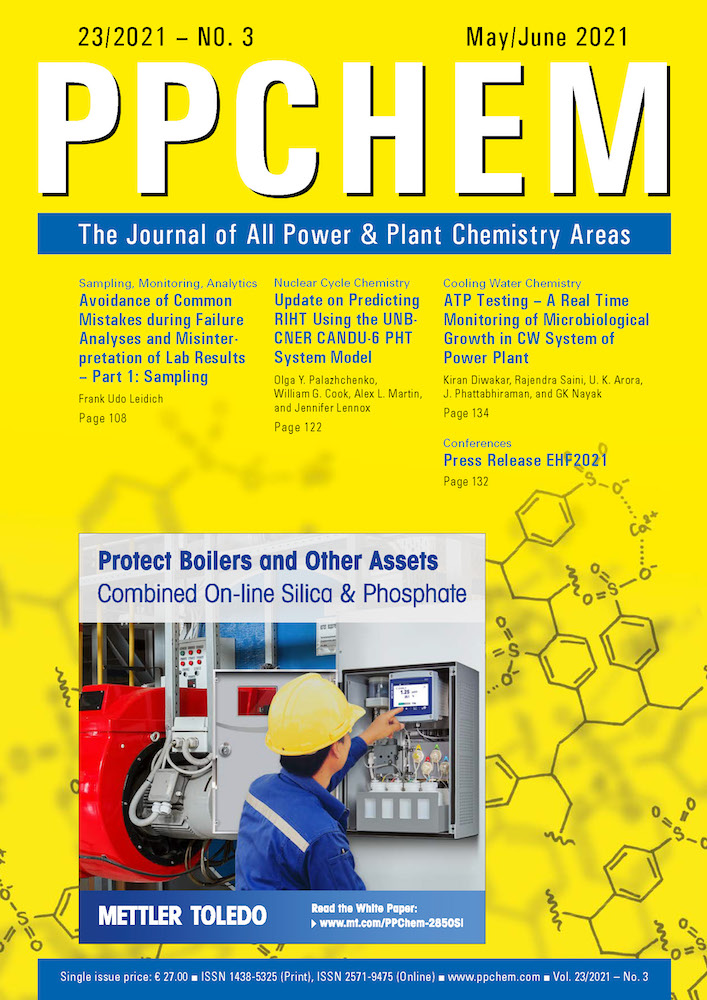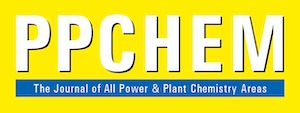
For members only
ABSTRACTS
Avoidance of Common Mistakes during Failure Analyses and Misinterpretation of Lab Results – Part 1: Sampling
Frank Udo Leidich
For a proper failure analysis or root cause analysis (RCA) a great deal of data and evidence-based information is needed. Within this context, various types of samples from different locations need to be taken for chemical and/or metallurgical examination. Therefore, proper and correct sampling, without alteration of the composition or contamination of the samples, is of utmost importance. Unfortunately, this is often not practiced correctly and so the risk of incorrect conclusions is high. This article is intended to help personnel obtain these samples in a proper manner and avoid common and repeated mistakes.
PPCHEM® 2021, 23(3), 108–119
For Members only
Update on Predicting RIHT Using the UNB-CNER CANDU-6 PHT System Model
Olga Y. Palazhchenko, William G. Cook, Alex L. Martin, and Jennifer Lennox
Reduced heat transfer in CANDU steam generators has safety consequences such as lower margins to fuel dryout due to higher reactor inlet header temperature (RIHT). To identify methods to maintain the RIHT within operational margins, it is necessary to model the effect of thermal degradation mechanisms on boiler heat transfer.
A comprehensive steam generator heat transfer and fouling add-on has been developed at the University of New Brunswick, Canada, and previously benchmarked using historic data from Point Lepreau Nuclear Generation Station. The one-dimensional, steady-state heat transfer code mechanistically predicts the effect of primary-side fouling, and semi-empirically models the effects of divider plate leakage and secondary-side fouling. This paper presents the most recent predictive modelling, where simulations of post-refurbishment operation (2012–2042) were conducted based on the benchmarked mechanisms. The predictive simulations inform the timeline for mitigating strategies such as a primary-side clean during the plant’s operating lifetime.
PPCHEM® 2021, 23(3), 122–131
For Members only
IAPWS Seventh Meeting of the European HRSG Forum (EHF2021)
Highlights and Press Release
Barry Dooley and Bob Anderson
The seventh annual IAPWS European HRSG Forum was held on the 18th and 20th May 2021 as a virtual event. It was chaired by Barry Dooley of Structural Integrity and Bob Anderson of Competitive Power Resources. EHF2021 attracted 90 participants from 17 countries and included 55 users.
EHF is supported by the International Association for the Properties of Water and Steam (IAPWS) and is held in association with the Australasian Boiler and HRSG Users Group
(ABHUG) and the US HRSG Forum (HF). The 2021 EHF had two sponsors: Trace Analysis and Swan Analytical Instruments. The conference was organized by PPCHEM AG.
PPCHEM® 2021, 23(3), 132–133
ATP Testing – A Real Time Monitoring of Microbiological Growth in the Cooling Water Systems of Power Plants
Kiran Diwakar, Rajendra K. Saini, Upain Kumar Arora, Janakiraman Pattabhiraman, and Gopi Kanta Nayak
In power plants, the warm environment of recirculating cooling systems is ideal for the growth of microorganisms. As microorganism communities grow in cooling systems, they can attach to tubes, pipe walls, and cooling tower fills, and form biofilms. Uncontrollable biological growth causes fouling, loss of heat exchange capacity, equipment failure, and energy wastage.
Due to the large volume of a cooling system with a flow rate of 60000–75000m3·h–1 (500 MW plus unit) and the diverse types of bacteria, spores, and algae, no one chemical can kill everything. There must be proper selection of a biocide, adequate contact time, and real time monitoring techniques to allow control of biological problems.
The best solution for any system is the fast and early detection of biological contamination, and the setting up of proactive actions and subsequent corrective treatments. For the measurement of microbiological counts, we can use culture tests like the heterotrophic plate count (HPC) method. However, these culture tests only measure culturable organisms while adenosine triphosphate (ATP) testing measures all microorganisms within a sample. There are two types of ATP – intracellular ATP contained within living biological cells and extracellular ATP located outside of biological cells, which has been released from dead or stressed organisms.
In one thermal power plant cooling water system of NTPC Ltd., India, this technique was demonstrated with successful results.
PPCHEM® 2021, 23(3), 134–142


